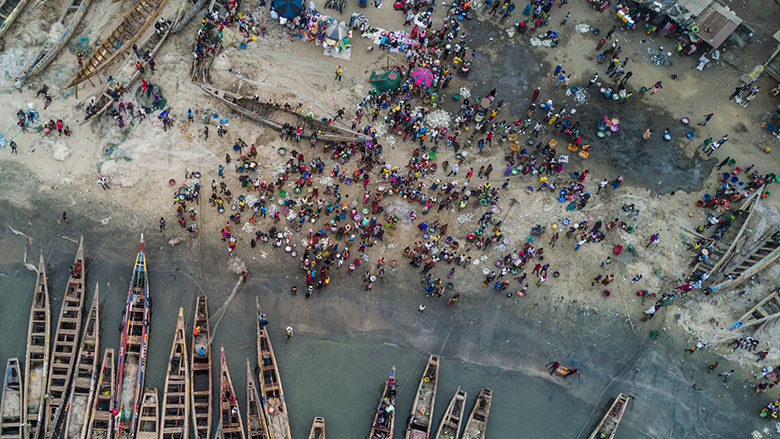Blog |
Integrated Fisheries Management for Coastal Communities’ Resilience in Guinea
In Guinea, the fisheries sector contributes to 3.7 percent of the gross domestic product (GDP).
Challenge
In Guinea, the fisheries sector contributes to 3.7 percent of the gross domestic product (GDP) in 2019. However, it is underexploited; in 2019, 165,000 tons were produced out of a potential of 300,000 tons. Illegal fishing is the main threat to the sector, causing a shortfall estimated at $20 million per year. Artisanal fishing and fish processing are the main means of livelihoods for 200,000 people and their families, including 34,532 fishermen and 25,000 in fish trading and processing activities. It is crucial to develop a sector currently hampered by a lack of secure access to the resources and appropriate landing and fish processing infrastructure.
Approach
The West Africa Regional Fisheries Program (WARFP) project, in Guinea, supported the fisheries sector to be more transparent, better regulated and institutionally solid. It also addressed the urgency to modernize management tools for better planning, surveillance, and monitoring of the resources and the need to provide direct support to coastal communities heavily dependent on fisheries. The project helped these communities secure access to the fisheries resources and to markets, and diversify their sources of income.
The joint use of IDA and GEF funding allowed for the modernization of landing and processing infrastructure, the co-management of the resources to include communities in the decision-making process, and the creation of alternative income-generating activities. These results led to the reduction of pressure on fisheries while ensuring the resilience of coastal communities, especially those affected by the COVID-19 crisis.
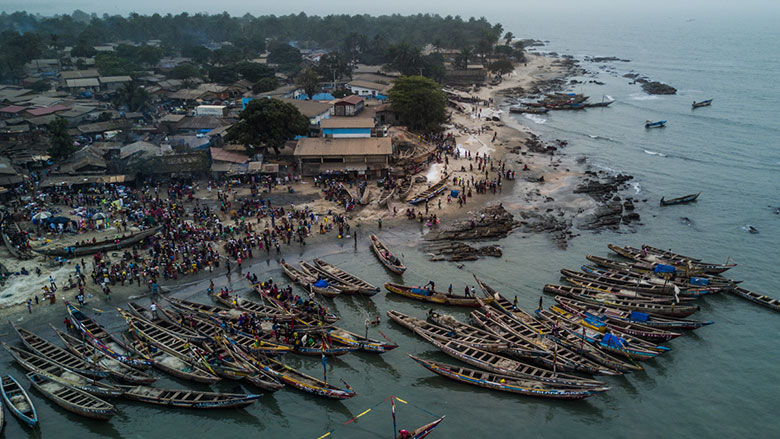 Artisanal fishing port of Koukoude, prefecture of Boffa, Guinea. Photo: Vincent Tremeau/World Bank
Artisanal fishing port of Koukoude, prefecture of Boffa, Guinea. Photo: Vincent Tremeau/World Bank
Results
The WARFP project in Guinea helped support several key outcomes:
- Increased transparency of the sector with the regular publication and dissemination of fisheries data since 2015 (industrial and artisanal licenses, infractions and catch).
- Resources co-management placing communities at the center of the process with the development of annual fisheries management plans since 2016 based on stock assessments, the creation of two community co-management associations and related local co-management plans in 2020.
- Management of fishing capacity while respecting the regulations imposed for each fishing category allowing less than 10,000 artisanal canoes and 85 industrial fishing vessels through improved and targeted law enforcement with a regular increased efficiency since 2015.
- Increased law enforcement and fight against illegal fishing with an operational satellite Vessel Monitoring System; more than 90 percent of industrial vessels were inspected in 2020 (compared to 51 percent in 2016), 300 percent increase in surveillance patrols (696 days of patrols in 2019 compared to 232 in 2016); and more than 80 percent of artisanal fishing canoes registered in 2020.
- Increased processed production capacity respecting improved hygiene standards. A newly constructed landing site and smoking facility led to 70 tons of fish processed in 2020.
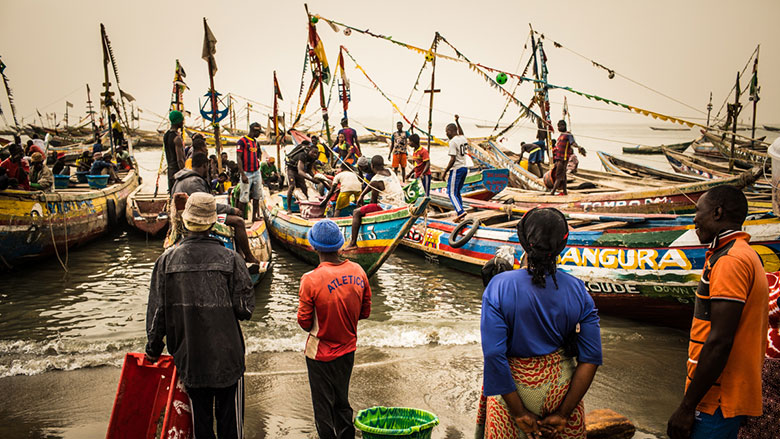 Artisanal fishing port of Koukoude, prefecture of Boffa, Guinea. Fish sellers wait on the shore for the fishermen to come back with the fish they collected. Photo: Vincent Tremeau/World Bank
Artisanal fishing port of Koukoude, prefecture of Boffa, Guinea. Fish sellers wait on the shore for the fishermen to come back with the fish they collected. Photo: Vincent Tremeau/World Bank
World Bank Group Contribution
The WARFP is made up of a set of investments from IDA, GEF and other trust funds in eight coastal West African countries (Cabo Verde, Ghana, Guinea, Guinea-Bissau, Liberia, Mauritania, Senegal, Sierra Leone) and with the support of the Sub-regional fisheries commission (SRFC) for a total of $170 million. Investments in Guinea totaled $15 million, including $10 million IDA funding as part of the parent project ‘’West Africa Region Fisheries Program additional financing Guinea, Sierra Leone & Liberia” in 2015, and an additional $5 million GEF funding in 2017. The project implementation has been supported by technical assistance developed through the Regional Partnership for African Fisheries Policy Reform ($2 million).
Partners
The WARFP project was coordinated with other West African countries under the Sub-regional Fisheries Commission which supported the harmonization of legislation, the development of regional surveillance strategies and fisheries data collection. Project interventions were coordinated with main partners including the Japan International Cooperation Agency, the MAVA Foundation and the Regional Partnership for Coastal and Marine Conservation in West Africa as part of the Fisheries Transparency Initiative. In addition, the strengthening of the fisheries sector under the project enabled Guinea to re-engage with the European Union on fisheries agreements.
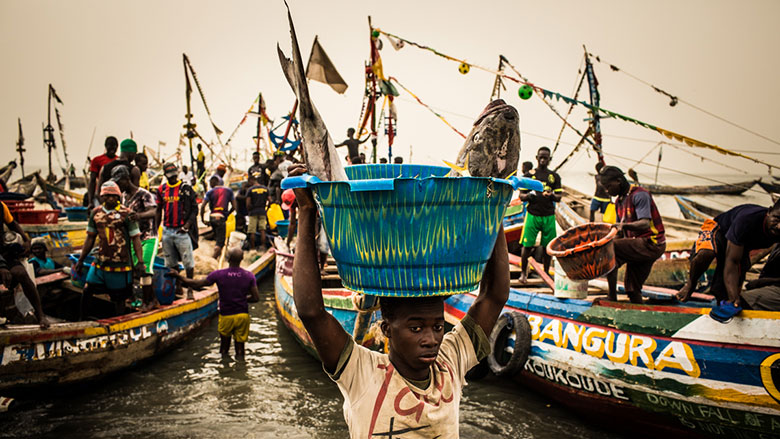 Artisanal fishing port of Koukoude, prefecture of Boffa, Guinea. A man comes back with a big fish that he will sell on the shore. Photo: Vincent Tremeau/World Bank
Artisanal fishing port of Koukoude, prefecture of Boffa, Guinea. A man comes back with a big fish that he will sell on the shore. Photo: Vincent Tremeau/World Bank
Moving Forward
The project helped reorganize Guinea’s fisheries sector. It is also developing a long-term strategy and investment plan, which will lay the foundation of the future development of the sector.
Through the ProBlue trust fund, the World Bank will support the use of data and technologies, integrated planning processes and economic valuation of marine and coastal environmental services. Through a proposed new IDA funding for Guinea to improve the management of natural resources and mining, the World Bank will continue to support the fisheries sector as a key natural resource in Guinea.
Beneficiaries
M’mah Soumah was not fortunate enough to attend school because the only school dedicated to the 28,000 Guinean deaf-mutes is 100 km away. To help feed her family, she went to live in the coastal village of Koukoudé, Boffa, Guinea where she sells smoked fish.
Koukoudé is a fishing area par excellence and is also recognized for its tourist potential. This fishing village is one of the largest artisanal fishing centers in the country with nearly 200 canoes and more than 100 tons of fish caught each year.
Despite these advantages, there is a stark contrast between Koukoudé’s potential and the communities’ poverty whose only mean of livelihood is fishing. But for M’mah and many other fishers ’families facing security and lack of alternatives, there is hope: the WARFP project will help them manage the fisheries and transform their future.
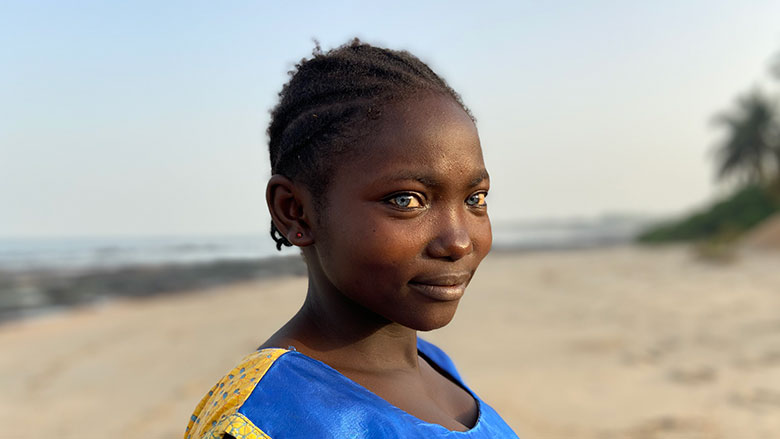 M’mah Soumah's portrait. Photo: Mamadou Bah/World Bank
M’mah Soumah's portrait. Photo: Mamadou Bah/World Bank
